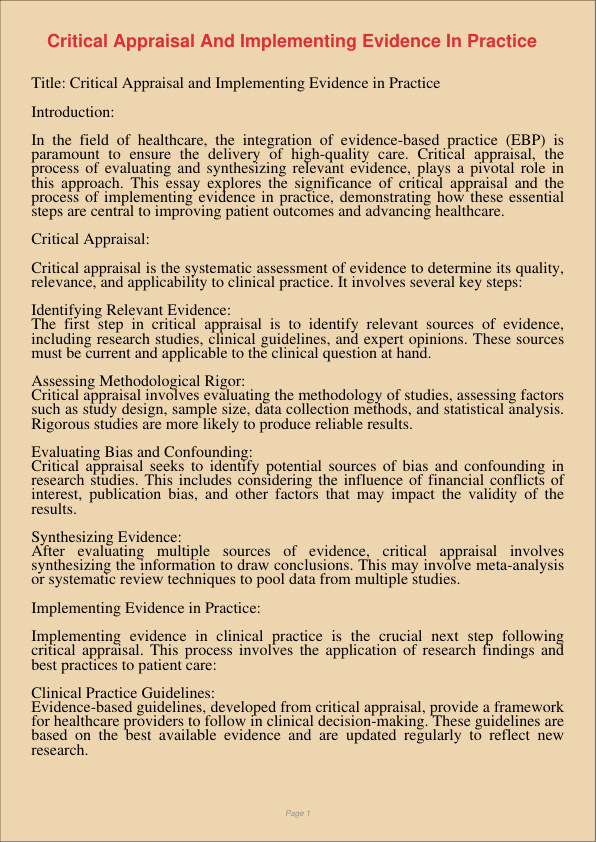Critical Appraisal And Implementing Evidence In Practice
Jan 9, 2024
implementing evidence
critical appraisal
Environmental Studies
Business
Title: Critical Appraisal and Implementing Evidence in Practice
Introduction:
In the field of healthcare, the integration of evidence-based practice (EBP) is paramount to ensure the delivery of high-quality care. Critical appraisal, the process of evaluating and synthesizing relevant evidence, plays a pivotal role in this approach. This essay explores the significance of critical appraisal and the process of implementing evidence in practice, demonstrating how these essential steps are central to improving patient outcomes and advancing healthcare.
Critical Appraisal:
Critical appraisal is the systematic assessment of evidence to determine its quality, relevance, and applicability to clinical practice. It involves several key steps:
Identifying Relevant Evidence: The first step in critical appraisal is to identify relevant sources of evidence, including research studies, clinical guidelines, and expert opinions. These sources must be current and applicable to the clinical question at hand.
Assessing Methodological Rigor: Critical appraisal involves evaluating the methodology of studies, assessing factors such as study design, sample size, data collection methods, and statistical analysis. Rigorous studies are more likely to produce reliable results.
Evaluating Bias and Confounding: Critical appraisal seeks to identify potential sources of bias and confounding in research studies. This includes considering the influence of financial conflicts of interest, publication bias, and other factors that may impact the validity of the results.
Synthesizing Evidence: After evaluating multiple sources of evidence, critical appraisal involves synthesizing the information to draw conclusions. This may involve meta-analysis or systematic review techniques to pool data from multiple studies.
Implementing Evidence in Practice:
Implementing evidence in clinical practice is the crucial next step following critical appraisal. This process involves the application of research findings and best practices to patient care:
Clinical Practice Guidelines: Evidence-based guidelines, developed from critical appraisal, provide a framework for healthcare providers to follow in clinical decision-making. These guidelines are based on the best available evidence and are updated regularly to reflect new research.
Education and Training: Healthcare professionals need to be educated about the latest evidence and guidelines. This includes training in the proper use of new technologies, medications, and procedures based on the best available evidence.
Continuous Quality Improvement: Healthcare organizations must create a culture of continuous improvement, which includes regular evaluation of clinical outcomes and the implementation of evidence-based interventions to address identified areas for improvement.
Patient-Centered Care: Involving patients in shared decision-making based on the best evidence ensures that care is tailored to individual patient needs and preferences.
Conclusion:
Critical appraisal and implementing evidence in practice are integral components of providing high-quality healthcare. These processes ensure that clinical decisions are based on the most current and reliable evidence available, leading to better patient outcomes, improved safety, and increased efficiency in healthcare delivery. In a constantly evolving field like healthcare, it is crucial for professionals to embrace and consistently apply the principles of critical appraisal and evidence-based practice to stay at the forefront of the industry.
